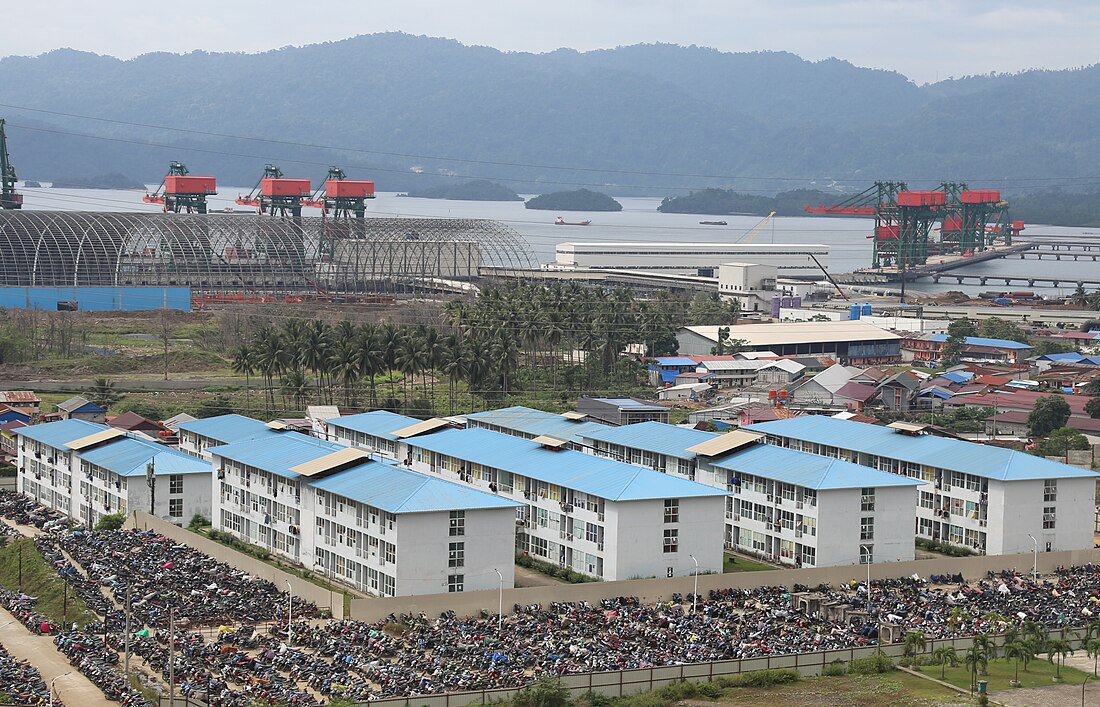Top Qs
Timeline
Chat
Perspective
Morowali Regency
Regency in Central Sulawesi, Indonesia From Wikipedia, the free encyclopedia
Remove ads
Morowali Regency is a regency of Central Sulawesi Province of Indonesia. It covers a land area of 5,472 km2. The districts currently within the regency had a combined population of 102,228 at the 2010 Census;[2] the regency population at the 2020 Census was 161,727;[3] and with rapid growth in the regency's population in recent years the official estimate as at mid 2024 was 198,968 (comprising 106,590 males and 92,378 females).[1] The administrative centre is at the town of Bungku (in Bungku Tengah District). The Regency includes the far-flung Menui Islands (Kepulauan Menui), lying to the southeast of the rest of the province.
Remove ads
History
Summarize
Perspective
Before Dutch rule, the region comprising what is today Morowali was the territory of the Kingdom of Bungku. After Dutch annexation, it was administered as the landschap of Boengkoe.[4] On 4 October 1999, Morowali Regency was created out of a portion of Poso Regency.[5] At that time it was composed of the southeastern fourteen districts from the Poso Regency.
On 12 April 2013 this Morowali Regency was in turn divided into two Regencies; the seven northernmost districts were split off to form a new North Morowali Regency (Morowali Utara) covering nearly two-thirds of the area of the then Morowali Regency, while the seven southernmost districts were retained as the residual Morowali Regency, although two additional districts were created by the division of existing ones.
Economy
Morowali Regency contains rich deposits of high-quality nickel, a vital material needed to manufacture lithium batteries. Starting in the 2010s and into the 2020s, the thriving nickel industry in Morowali has resulted in a large increase in the region's GDP (300% increase between 2013 and 2019),[6] but the expansion of the extraction industry has also caused environmental degradation.[6] From 2014 to 2020, over US$6.5 billion in foreign direct investment has flowed into the construction of nickel smelters and other downstream processing activities in Morowali Regency. Morowali is the site of an industrial park, the Morowali Industrial Park, specifically earmarked for refining activities. In Morowali, GDP more than tripled in just six years from Rp 6.9 trillion (US$480 million) in 2013 to Rp 24.3 trillion (US$1.7 billion) in 2019, almost all of it driven by investment in downstream nickel processing. As of 2021, the largest foreign investors were American, Chinese, and Japanese companies, while the government of Indonesia is attempting to build a domestic battery industry.[6]
The growth of this facility has resulted in the rapid expansion in the population, particularly in Bahodopi District where the mine is situated. The increased workforce migrating into the area has been largely male, resulting in a substantively high gender ratio in the regency.
Remove ads
Administrative districts
Summarize
Perspective
The Morowali Regency was divided (following the creation of the separate North Morowali Regency in 2013) into seven districts (kecamatan), but two further districts (Bungku Pesisir and Bungku Timur) were later created. These are all tabulated below with their areas and their populations at the 2010 Census[2] and 2020 Census,[3] together with the official estimates as at mid 2024.[1] The table also includes the location of the district headquarters, the numbers of administrative villages in each district (totaling 126 rural desa and 7 urban kelurahan), and its postal codes.
Notes: (a) the Sombori Islands District was formed in 2022 from part of Menui Islands District (10 villages/desa) plus part of South Bungku District (3 villages/desa).
(b) the 2010 and 2020 Census populations are included in the figures for Menui Islands and South Bungku Districts, from which they were taken.
(c) until 2022 this was partly on Sulawesi island (and comprising the most southeastern part of the province), but is now reduced to the island group to the southeast of the rest of the province. The largest are Menui Island (Pulau Menui) and the two Padui Islands. (d) including one kelurahan (Ulunambo).
(e) until 2022 this included a group of islands (Sombori Islands) off the northeast coast of Bungku Selatan, of which the largest are Umbele (Pulau Umbele Gunung), Paku, Waru-Waru and Pado-Pado. These have now been removed to the newly-formed district of that name.
(f) the 2010 populations of Bungku Pesisir District and Bungku Timur District are included in the figures for the Districts from which they were cut out in 2013.
(g) including 6 kelurahan (Bungi, Lamberea, Marsaole, Matano, Mendui and Tofoiso).
Remove ads
References
Wikiwand - on
Seamless Wikipedia browsing. On steroids.
Remove ads





